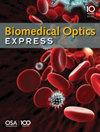利用各种光声成像系统对人体牙齿进行活体成像。
IF 3.2
2区 医学
Q2 BIOCHEMICAL RESEARCH METHODS
引用次数: 0
摘要
龋齿会引起疼痛,如果得不到诊断,在极端情况下可能会导致牙齿脱落。牙科 X 射线成像是检测龋齿的黄金标准,但它无法检测出隐藏的龋齿。此外,X 射线辐射的电离性也是另一个令人担忧的问题。因此,人们正在探索光声(PA)成像等其他成像模式用于牙科成像。在这里,我们展示了声学分辨率光声显微镜(ARPAM)对金属填充物牙齿成像、环形光声计算机断层扫描(cPACT)对龋齿和色素沉着牙齿成像以及线性阵列光声成像(lPACT)对龋齿和色素沉着牙齿成像的可行性。通过 lPACT 成像测量的龋洞与 X 射线计算机断层扫描图像进行比较。与 532 纳米波段的图像相比,1064 纳米波段的 cPACT 图像更能代表牙齿表面。使用 lPACT 成像可以检测到牙本质中存在的龋洞。使用 lPACT 系统成像时,牙齿侧面(咬合视图)色素龋的 PA 信号很高。本文章由计算机程序翻译,如有差异,请以英文原文为准。
Ex vivo human teeth imaging with various photoacoustic imaging systems.
Dental caries cause pain and if not diagnosed, it may lead to the loss of teeth in extreme cases. Dental X-ray imaging is the gold standard for caries detection; however, it cannot detect hidden caries. In addition, the ionizing nature of X-ray radiation is another concern. Hence, other alternate imaging modalities like photoacoustic (PA) imaging are being explored for dental imaging. Here, we demonstrate the feasibility of acoustic resolution photoacoustic microscopy (ARPAM) to image a tooth with metal filling, circular photoacoustic computed tomography (cPACT) to acquire images of teeth with caries and pigmentation, and linear array-based photoacoustic imaging (lPACT) of teeth with caries and pigmentation. The cavity measured with lPACT imaging is compared with the X-ray computed tomography image. The metal filling and its boundaries are clearly seen in the ARPAM image. cPACT images at 1064 nm were a better representative of the tooth surface compared to the images acquired at 532 nm. It was possible to detect the cavities present in the dentine when lPACT imaging was used. The PA signal from the pigmented caries on the lateral surface (occlusion view) of the tooth was high when imaged using the lPACT system.
求助全文
通过发布文献求助,成功后即可免费获取论文全文。
去求助
来源期刊

Biomedical optics express
BIOCHEMICAL RESEARCH METHODS-OPTICS
CiteScore
6.80
自引率
11.80%
发文量
633
审稿时长
1 months
期刊介绍:
The journal''s scope encompasses fundamental research, technology development, biomedical studies and clinical applications. BOEx focuses on the leading edge topics in the field, including:
Tissue optics and spectroscopy
Novel microscopies
Optical coherence tomography
Diffuse and fluorescence tomography
Photoacoustic and multimodal imaging
Molecular imaging and therapies
Nanophotonic biosensing
Optical biophysics/photobiology
Microfluidic optical devices
Vision research.
 求助内容:
求助内容: 应助结果提醒方式:
应助结果提醒方式:


